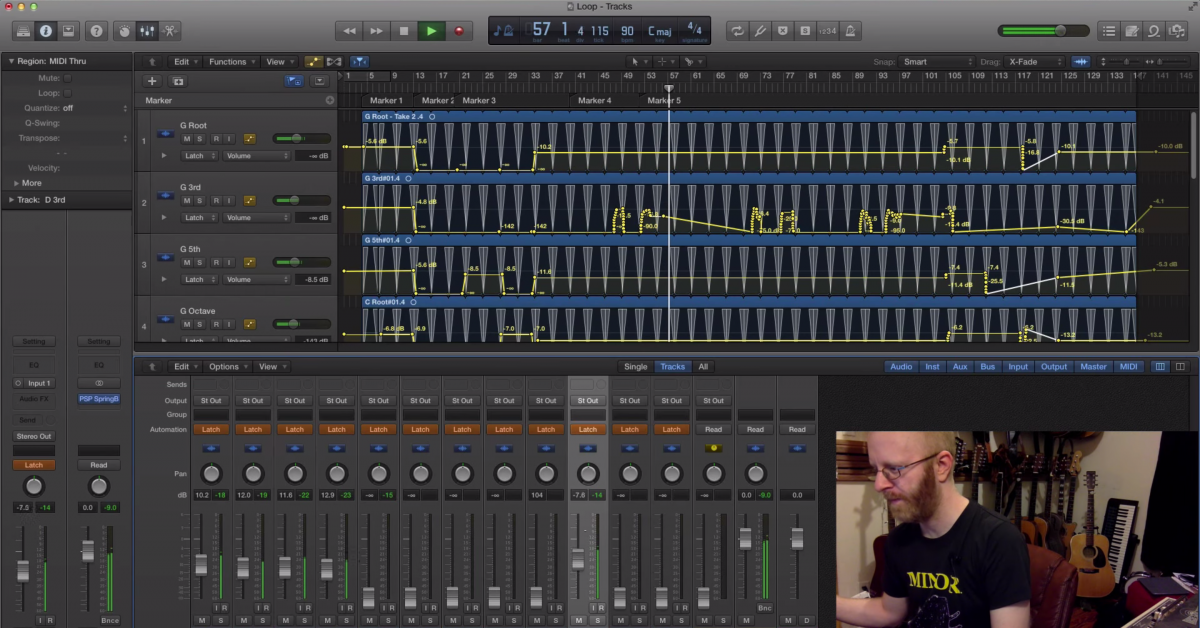Creating Ambient Atmospheres with Guitar and Effects Manipulation
Last week, I had a session with my good friend, Nick Oddy, who’s an awesome composer, and a member of the band, Zammuto. We got together, and we wanted to explore making some ambient guitar atmospheres with the concept being using these for scoring film, or some other abstract uses.
The idea was to try to make the guitar not sound like a guitar at all, and we were going to employ a lot of different processing to achieve this. I’m going to show you some video of our setup, and the way that we achieved the live manipulation of the sounds.
Now, the one thing worth noting about this is I was in the live room with a bunch of effects setup, and Nick was in the control room. He also had a bunch of effects patched in, and recorded to separate tracks that he was manipulating live on-the-fly.
The cool thing was as I did something, he would hear something and respond to it, and I would hear that back in the phones, so I would respond to it, so there was this cool cycle going on of us creating these other-worldly effects, and feeding off of each other.
So, check this out in the first installment. Next week, I’m going to open up Logic’s session and rip them apart a little bit more, and talk about how we can manipulate all of these tracks that we developed from this session.
Here’s my signal chain for these ambient guitar tracks we’re recording today. I have a pretty long chain of effects here. I’m first running into this Wah-wah. I’m using this Zevex Fuzz Factory, into this Creation Audio Grizzly Bass pedal, and I’m basically using that to tame the Fuzz Factory sometimes, because it can be a little harsh, so basically I’ve cut out a lot of the highs, then sucked a little of the mids out. Right now, I have quite a bit of gain on it.
I have the Super Trim, the Tremolo, I’m using the Zevex Loop Junkie, for kind of an old world, warped record sound. The Strymon El Capistan for loop and weird tape effects, the Effectrode Tube Drive, which generally stays on. I’m kind of just using it at the front end of the amp for a bit of warmth.
Now, we’re using this Eventide H9 Max, which we’re controlling on a stand here via iPad, so it can control some of the parameters. Right now for this ambient stuff, we’re using a lot of the harmonization effects, and just tweaking them, tweaking the key and tempo, and from the H9, it’s going into this Tube Spring Reverb, which sometimes is on or off, and then, we’re going into the Victoria 35 115 Combo, with a 15 inch speaker. Tweed amp, and it’s mic’d with a Cascade Fat-head.
Alright, now notice the dry sound with the tube *.
[plays guitar while demonstrating effects pedals]
I’m using the wah-wah sometimes. This is the really broken, nasty sound of that. This is the Grizzly Bass, the tremolo, the lo-fi, the El Capistan…
Sometimes what I do is this.
And then we have this H9.
[electric guitar with H9 adjusting]
And just using various combinations of these.
[electric guitar]
Nick: Alright, so there’s your dry signal. This is just your guitar, whatever you had. I’m not sure what you were playing. It sounds pretty –
Mark: Harmonizer with a slight delay on it. Very gentle.
Nick: So the Eventide H3000 from the late 80’s. I think 87, 88, something like that, once belonged to – I bought it from Laurie Anderson, from her and Lou Reed’s studio. I think this is – I’m not sure what the effect is, I was just kind of dancing around while you were playing. I mean, it’s obviously some sort of chorus, but I’m not sure specifically what patch it was.
Mark: So you have this split up, so you have the dry guitar track.
Nick: Yeah, I’m sorry, you’ve got the dry guitar track. That’s this right here. The dry guitar track has a buss sent to this box to get that effect, then this box had a buss going to stereo buss going to the Lexicon LXP1 reverb, and that’s this.
The cool thing is you could… There’s the reverb by itself. So, that’s your guitar, and the H-3000 into the reverb, with just the reverb isolated. Now we can get all sorts of wonderful combinations.
It looks like we’ve got something on the PCM-40 on here, which is a digital delay. Also by Lexicon. Not sure what it’s doing. Let’s see… Oh. Sort of a – the delay with the LFO, er, sorry, the VCO on it making a little * so there we’ve got…
There’s your dry guitar.





